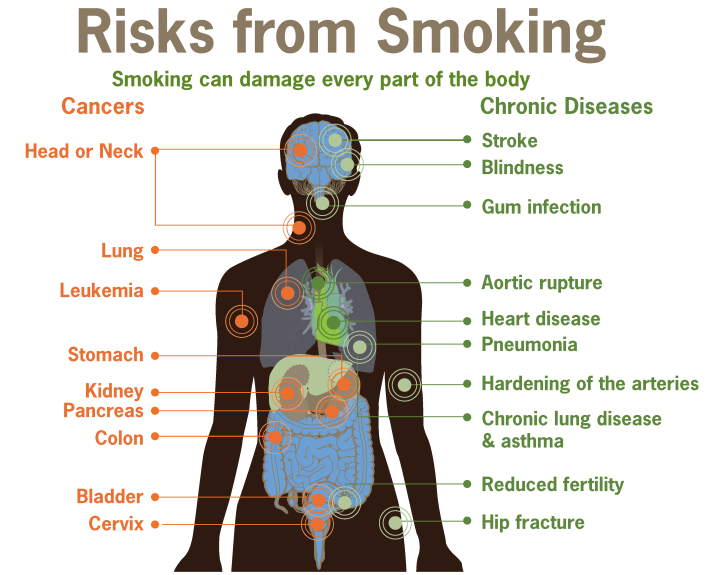Effects of Smoking on the Body
Posted on November 12, 2014 in Cancer
Smoking is bad for your body, your wallet and the health of those around you.

Written by John H. Heinzerling, MD
This news should come as no surprise, of course. Thanks to decades of advances in medical science and significant changes to public policy, the dangers of smoking are well known and universally accepted these days.
As a result, fewer Americans use tobacco today than any time during the past 50 years. While 40 percent of U.S. citizens were regular smokers in 1965, that number has plummeted to 18 percent today.
Given the negative stigma that smoking has gained in the U.S., it may seem surprising that smoking remains a major public health crisis in the U.S.
In the U.S., smoking cigarettes is still the single greatest cause of preventable death.
Current statistics paint a troubling picture of smoking today:
- Smoking causes more than 500,000 deaths in the U.S. every year. This accounts for one in every five deaths.
- 16 million Americans are afflicted by a disease caused by smoking.
- Every day, more than 3,000 teenagers smoke their first cigarette.
- Every day, more than 2,000 teenagers and young adults transition from occasional smoking to daily smoking.
- More people die from smoking per year than from HIV/AIDS, drug and alcohol use, traffic accidents, and gun-related injuries combined.
The Effects of Smoking on the Body

Given that smoking remains a major health crisis, it’s helpful to continue educating people on the dangers of cigarettes and the effects of smoking on the body. While heavy smokers are at highest risk of disease and early death, doctors have determined that even smoking “the occasional cigarette” can lead to illness and disease.
This is due, in part, to the high levels of toxins, poisons, and carcinogens that can be found in each and every cigarette.
Each cigarette contains over 7,000 chemicals, including 70 that cause cancer.
So how do these chemicals affect the body?
The Cardiovascular System
Also known as the Circulatory System, the Cardiovascular System is and organ system made up of the heart, veins, blood vessels, and capillaries that are responsible for circulating blood, nutrients, and oxygen through the body.
- Stroke and heart attack—the top 2 causes of death in the U.S.—are frequently caused by smoking.
- Smoking as few as five cigarettes per day can cause the early signs of cardiovascular diseases.
- Smoking damages blood vessels by causing them to grow thick and narrowing the passageways for blood to travel.
The Respiratory System
The Respiratory System is made up of the lungs, airways, blood vessels, and muscles that are involved in the breathing process. Smoking is the leading cause of respiratory disease.
- Cigarette smoke in the lungs damages airways and damages or destroys the small air sacs, called alveoli, that are vital to your body’s ability to absorb oxygen.
- Smoking is the leading cause of COPD, which includes emphysema and chronic bronchitis. 80–90 percent of COPD deaths are caused by smoking.
- 90 percent of lung cancer deaths are caused by smoking.
The Long Term Effects of Smoking

Photo credit: Amanda Mills/CDC
For many smokers, the consequences of tobacco use are abstract. Since the long-term effects of smoking develop slowly, over time—with each cigarette chipping away at the body’s vital systems little by little—it can be difficult to recognize that irreparable damage is being done.
Even people who only smoke “the occasional cigarette,” or former smokers that have successfully quit, remain at serious risk.
The risk factors for disease and early death take years return to normal, non-smoking levels, if at all.
Along with COPD and coronary heart disease risks, smoking has been proven to cause abdominal aortic aneurysm, cataract, pneumonia, periodontitis, and cancers of all kinds.
Smoking is also believed to significantly contribute to a variety of other conditions and disorders, including the slowing of the body’s healing process, causing wounds to take longer to heal and increasing the risk of infection. infertility, and stomach ulcers.
If nobody smoked cigarettes, 30 percent of all cancer deaths in the United States would not occur.
Along with lung cancer, smokers frequently develop cancers in the following areas:
- Blood
- Cervix
- Colon and rectum
- Esophagus
- Kidney and ureter
- Larynx
- Liver
- Bladder
- Oropharynx
- Pancreas
- Stomach
- Trachea
- Bronchus
- Lung
Secondhand Smoke Effects
Secondhand smoke is created in two ways. Sidestream smoke is smoke that comes off the end of a lit cigarette. Mainstream smoke is smoke that is exhaled by someone smoking a cigarette.
Based on years of research, doctors have concluded that exposure to both kinds of secondhand smoke is dangerous to non-smokers, and that any amount of secondhand increases risk levels for illness and disease.
2.5 million non-smoking adults have died as a result of secondhand smoke since 1964.
The way secondhand smoke effects the bodies of non-smokers is similar to the damage cause by smoking. Along with irritation to the the nose, throat, and lungs, secondhand smoke has been proven to increase the risk of many forms of cancer.
Evidence suggests that secondhand smoke may be linked to:
- Lymphoma
- Leukemia
- Brain tumors in children
- Doctors also believe secondhand smoke may cause cancers of the larynx (voice box), pharynx (throat), nasal sinuses, brain, bladder, rectum, stomach, and breasts.
Children and pets are at high risk from secondhand smoke effects
Even though all non-smokers are put at risk by secondhand smoke, children, pregnant women, and pets face some of the most serious consequences.
Exposure to secondhand smoke while pregnant increases the chance of miscarriage, stillborn birth, low birth-weight, and other pregnancy and delivery complications.
Infants and children exposed to secondhand smoke are at an increased risk of sudden infant death syndrome (SIDS), upper respiratory and lung infections, ear infections, and more severe and frequent asthma attacks.
A recent study found that Cotinine (a byproduct of nicotine) was found in the urine of animals living in a household with a smoker. The more smokers and the higher number of cigarettes smoked caused Cotinine levels to increase. Exposure to secondhand smoke has been linked to lymphoma in cats as well as lung and nasal cancer in dogs.




